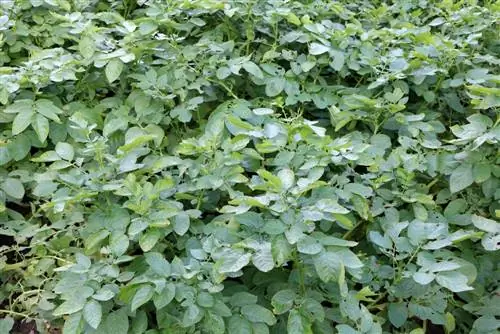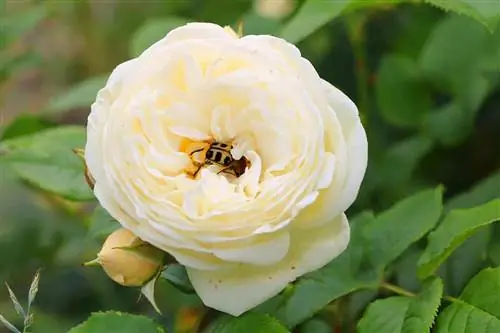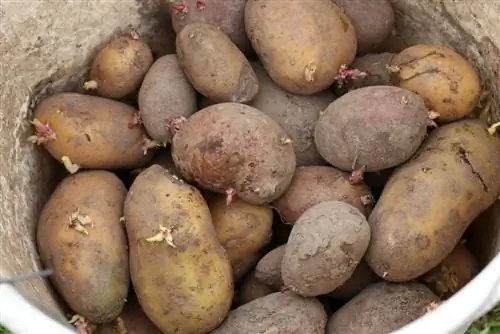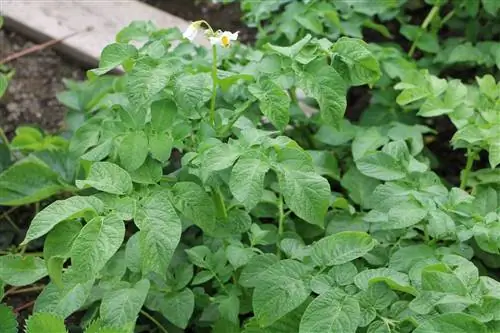- Author admin [email protected].
- Public 2023-12-17 03:39.
- Last modified 2025-01-24 12:45.
Botanically speaking, the potato (Solanum tuberosum) is a species of the nightshade genus (Solanum) of the nightshade family (Solanaceae). The species itself is divided into hundreds of varieties. What all varieties have in common is that their above-ground parts are poisonous to humans. That's why only the tuber is used to prepare dishes.
Toxicity for humans does not mean that pests have no taste for the potato plant. Therefore, all parts of the plant, not just the tubers, can be affected by a pest infestation.
Infection of above-ground parts of plants
Pests that like to eat the green part of the plant include:
- Aphids
- Potato beetle
- Aphids
Aphids are known to many hobby gardeners. The annoying pests cannot be kept away from almost any plant. Of the countless species of aphids, thirty specifically target potatoes. In addition, potatoes also serve as host plants for the small plum aphid, the oat aphid or the pea aphid.
Aphid colonies
For the majority of aphids that attack potatoes, the plants serve as summer hosts. The winged aphids settle on the potato plants in May and June and immediately begin to multiply, forming so-called aphid colonies. During this reproduction phase, the aphids almost completely stop their flight activity. Ideal conditions for infestation are:
- Temperatures above 17 degrees Celsius
- bright daylight
- Wind speeds below 3 meters per second
The aphid colonies “grow” on the underside of the leaves. If the plants are infected, the leaves become distorted and discolored. Reproduction without countermeasures only slows down at temperatures above 30 degrees Celsius, as the plants no longer make good hosts from the aphids' perspective. The number of natural enemies of aphids also increases at these temperatures.
Damage
Although the direct damage that aphids cause to the tubers is limited, through virus transmission they can reduce the harvest by up to four fifths.
Combat
Since young potato plants are particularly attractive to aphids, they must be combated as soon as the first signs of infestation appear.
Potato beetle
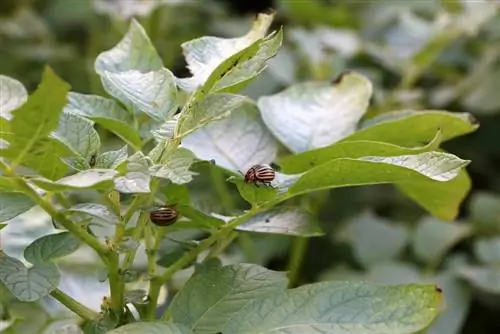
The Colorado potato beetle (Leptinotarsa decemlineata) from the leaf beetle family is one of the best-known pests. The first finds in Germany date back to 1877.
Appearance
The Colorado potato beetle is yellow and seven to fifteen millimeters long. Its pronotum has black spots. There are ten dark longitudinal stripes on the wing coverts.
Lifecycle
One to two generations can occur per year. In June, the beetles lay egg packets of 20 to 80 eggs on the underside of the leaves of the potato plant. A female alone can lay a total of 1,200 eggs. After three to twelve days, the reddish larvae hatch, which have black dots on the sides and head. After the larvae have shed their skin three times, they crawl into the ground to pupate after two to four weeks. After two weeks in the ground, the new generation hatches, around mid-July, and then remains in the ground for at least another week. After maturing for two to three weeks, the beetle hibernates in the ground.
malicious image
Beetles and larvae feed on the leaves of the potato. Colorado beetles find the young shoots of plants particularly tasty. But they don't stop at older plants and can quickly devour entire fields. Because a single larva eats a leaf area of 35 to 40 square centimeters!
The damage usually begins with pitting and edge corrosion. As a result, skeletal and leaf decay occurs, i.e. complete defoliation of the plants.
Combat
Since even chemical agents cannot prevent an infestation of Colorado potato beetles, it is better to prevent this pest. The simplest measure is to stretch a tight-meshed net over the potatoes. This way the beetles don't even get to the plants. Further measures include:
- Avoiding mineral fertilizers containing nitrogen
- Place peppermint and/or caraway between the potatoes
- Spray plants with peppermint tea (don't forget the bottom)
- Spread dry coffee grounds on the plants in the early morning hours
- Attract natural enemies
The natural enemies of the Colorado potato beetle include:
- Toads
- Caterpillar flies
- ground beetles
Although they cannot completely eradicate an infestation, these natural enemies can keep the infestation within limits.
Tip:
The best-known way to contain the plague is to collect the Colorado potato beetle by hand. What is important is the sheet on orunder which the beetle is sitting must also be removed immediately. This stops reproduction. You should then burn the beetles or destroy them in a bucket of water.
Infestation of underground plant parts
In addition to the pests that prefer the green parts of the potato, those that attack the underground parts of the plant include:
- Wireworms
- Cutterworms
Wireworms
Wireworms are the larvae of the click beetle family. Potatoes are particularly on the menu of the larvae of seed and humus beetles.
Appearance
Seed beetles are yellow-brown, brown or slightly blackish in color. Her body is densely gray insistent. Their wings have light and dark longitudinal stripes. Antennae and legs show a pinkish-red color. Humus click beetles have a rusty brown to brown-black color. Their legs and antennae are yellow-brown to brown.
Wireworms are elongated and golden yellow in color. They grow up to 2.5 centimeters long. Their head capsule is dark brown. Their hard chitinous skin is provided with bristles.
Life cycle of beetles
Click beetles are mainly found from mid-May to early July. Each female lays up to 300 eggs in the soil in June or July. The young larvae hatch after about four to six weeks. Depending on the weather and food availability, they need three to five years to complete their larval development.
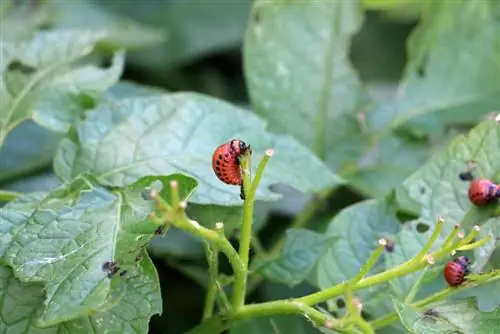
malicious image
As a rule, wireworms feeding on the roots of the potato plant are not noticed. However, if you have drilled holes in the potato, the infestation becomes immediately apparent. Wireworms drill holes in potatoes especially during prolonged drought. If the drought is only short-lived, they may have started drilling, but will stop doing so again. In this case, the drill holes are only a few millimeters deep. On the other hand, a real drilling passage can be up to three millimeters thick.
Combat
Since a wireworm infestation is difficult to detect, the soil should be checked for the pests before planting.
- Digging soil on a sunny and dry day
- Eggs and larvae do not like dryness
- Collect pests from the surface
Once the wireworms are on the surface, you can leave them to their natural enemies. These include:
- ground beetles
- Parasitic wasps
- Hedgehog
- moles
- Shrews
Wireworms are also very popular as food for the young of some bird species, such as crows and starlings.
Biological poison and traps
Wireworms can also be poisoned without using chemicals. Natural poisons for wireworms include:
- Tagetes
- Marigolds
If these flowering plants are placed between the potatoes, the infestation will not disappear completely, but it will at least be contained. Because the roots of these plants are poisonous to wireworms. Homemade traps made from potatoes also have a containment effect.
- Cut the potato into wide slices
- stick on wooden skewers
- Put about five centimeters into the ground
- check regularly
If the wireworms have gotten into the trap, pull out the skewers with the worms and dispose of them.
Tip:
For success, the process must be repeated several times.
Cutterworms
Earth caterpillar is the name for the larvae of some species of owl butterflies. Since the larvae mainly live in the soil, this name has become common. Potatoes are mainly infested by the winter sowing owl (Agrotis segetum).
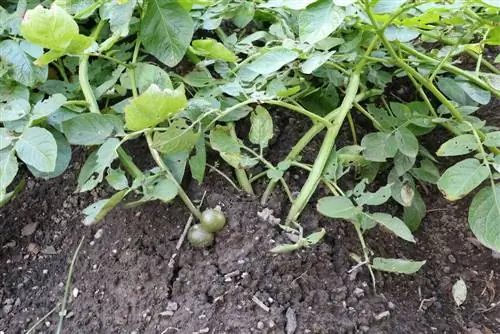
Lifecycle
Adult caterpillars overwinter in the ground. They pupate from May to June. Depending on the weather, the butterfly's flight takes place between the end of May and the beginning of July, with the second half of June being the peak flight. The females begin laying eggs on the ground two to seven days after hatching. Each female lays an average of 800 eggs.
The tuber eating begins with the 3rd larval stage and lasts several weeks. The caterpillars are considered particularly voracious in their last instar. These adult caterpillars overwinter in soil depths of 20 to 40 centimeters. They pupate in spring.
malicious image
Old cutworms primarily attack tubers in August and September. Young caterpillars first eat the leaves lying on the ground. Their feeding behavior becomes noticeable when they begin to eat the stems in the 2nd larval stage (pitting).
Combat
The only way to prevent an infestation with cutworms is to keep the owl moth away from the potatoes with a fine-mesh net.

